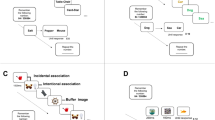Abstract
A failure to understand instances of selective association in the context of a general learning process results in a very superficial analysis.
Access this chapter
Tax calculation will be finalised at checkout
Purchases are for personal use only
Preview
Unable to display preview. Download preview PDF.
Similar content being viewed by others
References
Bolles, R.C. 1970. Species-specific defense reactions and avoidance learning. Psychol. Rev. 77: 32–48.
Coil, J.D., and Garcia, J. 1977. Conditioned taste aversion: The illness US. In Biological Approaches to Learning: Papers presented at the Northeastern Regional Meeting of the Animal Behavior Society, pp. 1–28. St. John’s, Newfoundland, Canada.
Durlach, P.J., and Rescorla, R.A. 1980. Potentiation rather than overshadowing in flavor-aversion learning: An analysis in terms of within compound associations. J. Exp. Psychol.: Anim. Behay. Proc. 6: 175–187.
Galef, B.G., Jr., and Osborne, B. 1978. Novel taste facilitation of the association of visual cues with toxicosis in rats. J. Comp. Physiol. Psychol. 92: 907–916.
Garcia, J., and Rusiniak, K.W. 1980. What the nose learns from the mouth. In Chemical Signals: Vertebrates and Aquatic Invertebrates, eds. D. Muller-Schwarze and R.M. Silverstein, pp. 141–156. New York: Plenum Press.
Gillette, K.; Martin, G.M.; and Bellingham, W.P. 1980. Differential use of food and water cues in the formation of conditioned aversions by domestic chicks (Gallus gallus). J. Exp. Psychol.: Anim. Behay. Proc. 6: 99–111.
Lett, B.T. 1983. Pavlovian drug-sickness pairings result in the conditioning of an antisickness response. Behay. Neurosci. 97: 779–784.
Lett, B.T. 1983. Pavlovian drug-sickness pairings result in the conditioning of an antisickness response. Behay. Neurosci. 97: 779–784.
LoLordo, V.M. 1979. Selective associations. In Mechanisms of Learning and Motivation: A Memorial Volume to Jerzy Konorski, eds. A. Dickinson and R.A. Boakes, pp. 367–398. Hillsdale, NJ: Lawrence Erlbaum Associates.
Mackintosh, N.J. 1977. Stimulus selection: Learning to ignore stimuli that predict no change in reinforcement. In Constraints on Learning: Limitations and Predispositions, eds. R.A. Hinde and J. Stevenson-Hinde, pp. 75–96. London: Academic Press.
Revusky, S. 1977. Learning as a general process with an emphasis on data from feeding experiments. In Food Aversion Learning, eds. N.W. Milgram, L. Krames, and T.M. Alloway, pp. 1–51. New York: Plenum Press.
Revusky, S., and Coombes, S. 1982. Long-delay associations produced in rats by injecting two drugs in sequence. J. Comp. Physiol. Psychol. 96: 549–556.
Revusky, S.; Coombes, S.; and Pohl, R.W. 1982. Drug states as discriminative stimuli in a flavor-aversion learning experiment. J. Comp. Physiol. Psychol. 96: 200–211.
Revusky, S., and Garcia, J. Learned associations over long delays. In The Psychology of Learning and Motivation: Advances in Theory and Research, ed. G. Bower, vol. 4, pp. 1–83. New York: Academic Press.
Rozin, P. 1976. The evolution of intelligence and access to the cognitive unconscious. In Progress in Psychobiology and Physiological Psychology, eds. J.M. Sprague and A.N. Epstein, vol. 6, pp. 245–280. New York: Academic Press.
Rusiniak, K.W.; Garcia, J.; and Hankins, W.G. 1976. Bait shyness: avoidance of the taste without escape from the illness in rats. J. Comp. Physiol. Psychol. 90: 460–467.
Rusiniak, K.W.; Palmerino, C.P.; Rice, A.G.; Forthman, D.L.; and Garcia, J. 1982. Flavor-illness aversions: Potentiation of odor by taste with toxin but not shock in rats. J. Comp. Physiol. Psychol. 94: 527–539.
Shettleworth, S.J. 1978. Reinforcement and the organization of behavior in golden hamsters: Punishment of three action patterns. Learn. Motiv. 9: 93–123.
Taukulis, H.K. 1974. Odor aversions produced over long CS-US delays. Behay. Biol. 10: 505–510
Wilcoxin, H.C.; Dragoin, W.B.; and Kral, P.A. 1971. Illness induced aversions in rat and quail: Relative salience of visual and gustatory cues. Science 171: 826–828.
Wilson, E.O. 1975. Sociobiology: The New Synthesis. Cambridge, MA: Belknap Press of Harvard University.
Author information
Authors and Affiliations
Editor information
Rights and permissions
Copyright information
© 1984 Berlin, Heildelberg, New York, Tokyo: Springer-Verlag
About this paper
Cite this paper
Revusky, S. (1984). Associative Predispositions. In: Marler, P., Terrace, H.S. (eds) The Biology of Learning. Dahlem Workshop Reports, vol 29. Springer, Berlin, Heidelberg. https://doi.org/10.1007/978-3-642-70094-1_22
Download citation
DOI: https://doi.org/10.1007/978-3-642-70094-1_22
Publisher Name: Springer, Berlin, Heidelberg
Print ISBN: 978-3-642-70096-5
Online ISBN: 978-3-642-70094-1
eBook Packages: Springer Book Archive




